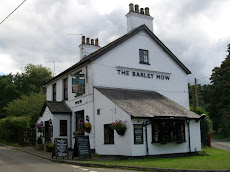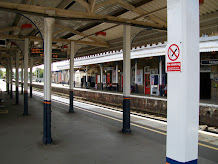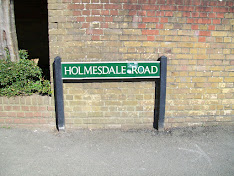My trip to Reigate, brought a previous sojourn that I had not previously published to mind. In ‘The Solitary Cyclist’, Violet Smith moves to ‘Chiltern Grange’ in Farnham on ‘the borders of Surrey’ to act as music teacher to the daughter of a Mr. Carruthers, who claims acquaintance with a seemingly dead relative of hers. Every Saturday forenoon she rides her bicycle to Farnham Station, in order to get the 12:22 to town. The road is a lonely one, and at one spot it is particularly so, for it lies for over a mile between Charlington Heath upon one side and the woods which lie round Charlington Hall upon the other. However, she finds herself being regularly followed by another cyclist, so seeks the support of Holmes and Watson.
Therefore, in August 2011, I decided to follow in her footsteps/bicycle tracks, catching a train to Guildford Station, then a bus to Puttenham Cross Roads. Nearby was an entrance onto Puttenham Common, the true identity of Charlington Heath. I walked swiftly across the Common, taking photographs.
I then passed Hampton Lodge, the true identity of Charlington Hall, continuing to enter the woodland. However, I decided to pop back for some more photos to be challenged by the owner of a nearby cottage, having not noticed a sign indicating that this part of the Common was private land. I apologised profusely, returning to the woodland, before managing to grab a couple more photos after he had gone.
Exiting the woodland onto a main road, it was then a two mile walk to my next stop, the Barley Mow Public House, where Holmes fought with Mr. Carruthers’ co-conspirator, Mr. Woodley, demonstrating his expertise in boxing.
“I found that country pub which I had already recommended to your notice, and there I made my discreet inquiries. I was in the bar, and a garrulous landlord was giving me all that I wanted,…..when who should walk in but [Mr. Woodley], who had been drinking his beer in the tap-room and had heard the whole conversation…..He ended a string of abuse by a vicious back-hander, which I failed to entirely avoid. The next few minutes were delicious. It was a straight left against a slogging ruffian. I emerged as you see me. Mr. Woodley went home in a cart” – Holmes [SOLI]
Continuing along for another three miles, I finally reached my (and Miss Smith’s) final destination, Farnham Station. The station was opened on 8 October 1849, on a route from Guildford via Ash Green and Tongham. The line from Aldershot station opened in 1870 and was electrified on 4 July 1937. It was to here to Holmes and Watson travelled to come to Miss Smith’s aid, with Holmes describing Farnham as "a beautiful neighbourhood and full of the most interesting associations. You remember, Watson, that it was near there that we took Archie Stamford, the forger." [SOLI]
I then caught a train back to Guildford, where I spent the evening enjoying a production of ‘The Woman in White’ by Wilkie Collins at the Yvonne Arnaud Theatre, featuring Sixth-Doctor actor, Colin Baker, as Count Fosco.
The production was enjoyable, if like the original novel, a little too long. This concluded, a late train took me home.
_1%20%20%5BSOLI%5D.JPG)
_2%20%20%5BSOLI%5D.JPG)
%20%5BSOLI%5D.jpg)
%20%5BSOLI%5D.JPG)
























